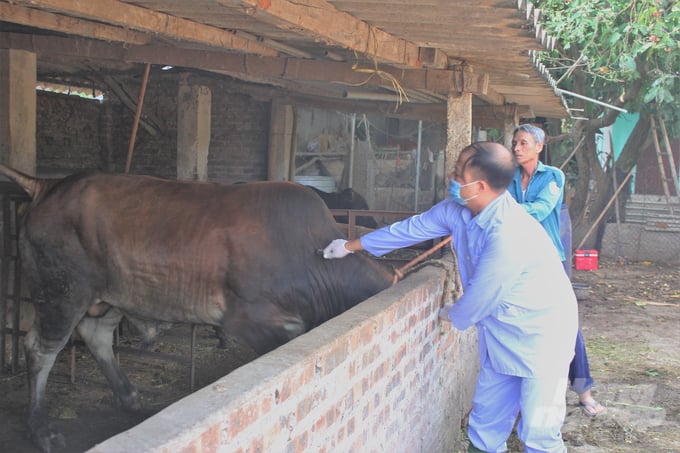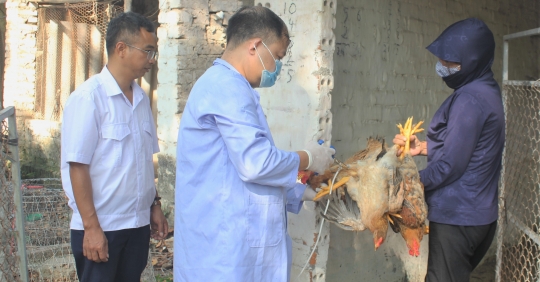According to the Ministry of Livestock and Veterinary Medicine of Vinh Phuc Province, the buffalo herd across the province is about 16,600 as of April 15; herd of 94,000 cows (dairy cows 17,300 heads); pig herd 458,000 head; Poultry flocks of almost 12 million animals. Production of buffalo meat is estimated at 452 tons, beef over 1,700 tons, live pork over 29,600 tons, poultry meat over 14,800 tons, fresh milk 20,500 tons and poultry eggs over 253 million.

Officials from Vinh Phuc Animal Husbandry and Veterinary Subdepartment inspect and assist district and city veterinary staff in vaccinating livestock and poultry and disinfecting breeding environment in the first phase of 2023. Image: Trung Quan.
Nguyen Hiep Khoi, deputy director of Vinh Phuc Animal Husbandry and Veterinary Sub-department, said that given the relatively large number of livestock and poultry (GSGC) in the province, disease prevention in livestock herds is of particular concern. At the very beginning of the year, the Ministry of Agriculture and Rural Development issued a plan to vaccinate GSGC and disinfect livestock based on the 2023 GSGC and Fisheries Epidemic Prevention and Control Plan of the Provincial People’s Committee. raised in 2023.
Accordingly, the Subdivision of Livestock and Veterinary Medicine will coordinate with the relevant authorities to organize two vaccination rounds for the GSGC and ECO spraying of livestock environment in the province (Phase 1: from April to May; Phase 2: from October to November) . Also, do additional vaccinations for newly reared and unvaccinated GSGC flocks during the peak season of the year during the remaining months of the year; injected to contain small provincial outbreaks.
In order to implement the vaccination effectively, the province has paid 100% of the cost of the cattle staph and foot-and-mouth disease (FMD) vaccine; foot-and-mouth disease, classical swine fever, blue eared ears in sows and boars; Avian flu vaccine for chicken and waterfowl flocks in households of 3,000 birds or fewer. At the same time, we cover 100% of the cost of buying chemicals for spraying around farm animals and support materials and tools for vaccination and spraying of stables.
Vinh Phuc Animal Husbandry and Veterinary Sub-department staff are following places in the province to inspect, hustle and support district animal husbandry and veterinary stations, and community animal protection forces are to carry out vaccinations for children. GSGC and KTTD breeding environment for the In the first phase of 2023 (from April 24 to May 25), it is easy to see that the atmosphere is urgent and can not cope day and night. The careful and precise behavior of the veterinary staff at all levels has contributed to the methodical and effective implementation of the vaccination work.
Mr. Tran Tan Dan, head of the Tam Duong District Animal Husbandry and Veterinary Station, said that Tam Duong is a district with a large livestock population of about 4 million poultry, 25,000 cattle and 100,000 pigs. Based on the guidance of professional officials and authorities from provincial to municipal level, people’s awareness and livestock husbandry methods have been gradually raised. Households have been proactive in ensuring hygiene in the stables and fully vaccinating the animals. As a result, there have been no dangerous diseases in livestock in the district in recent years.

Tam Duong District Animal Husbandry and Veterinary Station chief Mr. Tran Tan Dan (right) inspects and provides technical support on livestock waste treatment for farm owners who are not eligible for vaccination support and environmental control. Picture: Trung Quan.
During this vaccination campaign, the station has coordinated with relevant units to disseminate information and propaganda about the provincial vaccination plan, KT spray and support policies, so that livestock farms are informed and can take coordinated measures. In addition, the veterinary staff always increases the sense of responsibility in the implementation of the mission to ensure that the right kind of vaccine is vaccinated, the right target is reached, and KTTD is sprayed effectively to avoid loss and waste and ensure human safety guarantee. animals and environment.
“From the beginning of the year until today, livestock production has faced many difficulties. So this round of vaccination makes all the more sense if it helps households be more confident not to abandon herds, not be complacent about disease prevention and be ready to deliver when the market stabilizes again. From there, you secure the income, maintain the scale of production, and gradually expand it,” said Mr. Dan.
Mr. Hoang Tien Luan, Dinh Trung District, Vinh Yen City, has raised 2,000 broiler chickens, which he enthusiastically shared. The family’s main source of income for the year is from 3 litters of chickens (2,000 chickens/broilers) so you’ll hear about it all the time. Illness is like “sitting on the fire”. In the past, his family’s disease prevention and treatment of chickens was mainly based on experience, so they often suffered from the cost, but the chickens still died en masse.
However, by receiving information and guidance from veterinary staff at all levels; participate in technical training; His family listens to disease prevention and treatment information for chickens over the station’s speaker system, particularly with annual support for vaccinations and regular KTTD spraying, and can now “sleep on pillows.”

In 2023, Vinh Phuc Animal Husbandry and Veterinary Sub-department will coordinate with relevant authorities to organize two vaccination rounds of GSGC and ECO-spraying of livestock in the province. Picture: Trung Quan.
“Honestly, the current animal production based solely on experience of preventing and treating diseases in livestock is not good. Because experience only helps farmers to recognize a few common diseases, while there are now many new diseases with similar symptoms, but which can spread quickly, become complicated and develop quickly. Treatment is more difficult. Therefore, if there is no accompanying veterinary system and farm households do not actively adhere to vaccination and hygiene measures, they will have nothing,” Mr. Luan explained.
In 2023, the Vinh Phuc Ministry of Agriculture and Rural Development will develop a vaccination plan for the supported livestock and poultry, including: Vaccination against FMD type O and A for buffalo and cows with more than 147,300 animals; vaccines against pasteurellosis emulsifying buffalo and cows for more than 73,600 cows; FMD vaccine type O for sows and boars with more than 103,600 piglets; Blue ear vaccination for sows and boars in more than 103,500 piglets; attenuated swine cholera vaccine for 56,400 animals; Rabies vaccination for dogs and cats (provincial budget does not support) more than 37,300 animals; Vaccination against H5N1 and H5N6 bird flu for more than 7.2 million children.

